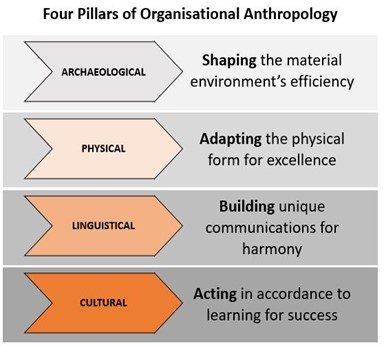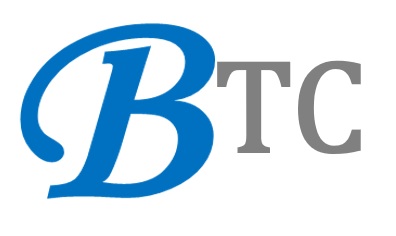

These 4 pillars give us The Anthrospective Views – to see things from a Holistic and Systems perspective to help us resolve organisation tensions with appropriate strategies and interventions to evolve a High Value Creation (HVC) organisation beyond the High-Performance Organisations (HPO’s) of today.
The four pillars definition are given below:
- Archaeological: Comparative study of past cultures through remnant leftovers and things uncovered
- Physical: Comparative study of human attributes – past & present behaviours that enable and drive excellence
- Linguistical: Comparative study of the language and communication style of people groups and how they harmonious with one another
- Cultural: Comparative study of own and “best practice” cultures for success
Thus, an organisation culture founded on anthropology will drive human behaviour along natural lines that makes value creation the main thrust in contrast to many of today’s organisations that are riddled with politics, back biting, self-preservation, and self-serving undercurrents.
But when properly understood and acted upon, it would create a truly world class Anthrophillic Organisations such as Southwest Airlines where people are at the heart of the organisation for creating value and meaning at the workplace.
When the Anthropology of Trust and Trust are integrated with Truthfulness to the extent where people can feel safe to make things happen instead of working hard to cover their backs – real value is created in terms service, delivery, experience etc. as compared to another airline, when a customer service staff was asked why is she “herding” the passengers into the queue: her response was, “If I don’t I will be scolded by my Boss” These are the atrocities of poor Anthro understanding.
Building A Talented Anthro Organisation
What Is Corporate Anthropology? Corporate anthropology is the process of looking at a company as a new and unfamiliar culture. By applying classic anthropological techniques—such as observational research and exploration— to business settings, it’s possible to arrive at new insights that help companies sustain growth and adapt to changing environments. Corporate anthropology is the key to seeing a business problem in a new light or finding previously unimagined opportunities, instead of remaining stuck by reverting to old habits, old solutions, or old cultures.
Our challenge is how to create an Anthrophillic Valuable Organisation by sensing the changing disruptions, embracing the opportunities, and becoming a winner instead of a whiner.
To do this, we need to think different, learn to explore and adapt to change by asking:
1. What is happenings and What is not happening
2. What is Changing and What is Unchanging
3. Asking New and Fresh Questions such as why is toilet paper white
4. Where are the potential disruptions?
5. How it affects us
6. Finding your own space
7. Reframing your context
8. Choosing a different audience or area to offer your skills or services
9. Playing by new rules or Creating New Rules
10. What we need to do, change, or stop doing
11. Where to Play
12. How to adapt
13. What to Offer
14. How to win
15. New Mind sets to adopt
16. The New Winning DNA
17. Imagining a better place
… in essence, how to change our game without the blame.
In Business and Leadership, achieving internal and external alignment by looking at things from an Anthropology Point of View is crucial to success. Companies must adapt to changing times by taking a step back and look at their companies with fresh eyes to see business situations through a new anthropology lens.
There are a few techniques we can use to do this.
Day in the Life.
This technique requires senior executives and CEOs to get out of their offices and literally spend a day following around their customers in order to gain a new perspective and insights to capture the essence of what people really value and want from a company.
It must be done without any preconceived ideas. Just merely observe and notice and like a camera just take snapshots of reality. The purpose of going exploring is to see things with fresh eyes. It is Important to separate judgement from Observation
Deep Hanging Out.
Deep Hanging Out Observe as an external observer and the subjects must be aware that you are deliberately studying what they are doing.
“Deep Hanging Out” is participating as part of the group. In fact, observations gleaned from deep hanging out often end up being the most meaningful insights of one’s anthropological research. The key is to ensure that you truly listen to those around you in order to gain authentic insights, while refraining from asking too many questions.
Culture Probes.
If you really want to know how your customers, employees & clients really “feel” about something—your products, services, workplace—a culture probe is a great option. Remember, since people buy with emotions and justify with logic, what they say and what you see is very important, but how they feel is perhaps even more valuable for you to get the insights of what you are looking for. Culture probes can include asking your customers to create diaries or blogs or providing your customers with packs of relevant objects. Culture probes are meant to reveal what is going on in the minds of the people you want to know more about, as you watch them deal with situations or apply certain products to solve their problems.
Customer Diaries.
When the goal is to learn more about a problem or customer, or when you want to go exploring to find new markets, to see how your employees are really doing their jobs, or to watch clients make relevant decisions, a great technique is to pick up a camera, an iPhone, an Android, or video camera and go out into the field to make a visual customer diary.
These will help a business leader “see, feel and think” more clearly about a particular problem and using images can help you formulate a pattern that makes sense out of what people are doing. The use of pictures and videos is an excellent way to capture what is happening. You will be amazed at the disconnect between what you think you are seeing or what people tell you they are doing and what those pictures or videos truly capture as you review them at a later time.
With them you, can discover needs that haven’t been met, customers they have never tried to reach, markets they have never imagined for phenomenal growth and success.
Culture Assessment.
Culture change starts by understanding what’s going on presently. An Organisational Culture Assessment Instrument is a sound way for getting an overview of your organisation’s culture. This assessment will complement nicely with the more personal angle and insights that come from other tools like deep hanging out and observational research
Engaging multiple influence sources will reinforce new changes with different voices. Having pictures and video from the moment, not a written diary later, enhances the authenticity of the information.
In recent years, some of the biggest names in business have recruited highly trained anthropologists to understand their workers and customers better, and to help design products that better reflect emerging cultural trends.
Companies are Desperate to Hire Anthropologist as they can arrive at customer insights that big data tends can’t.
This post is written by our Senior Advisor, Alan Teo from this book, “Creating Winning Culture and Building Supertalent”.

